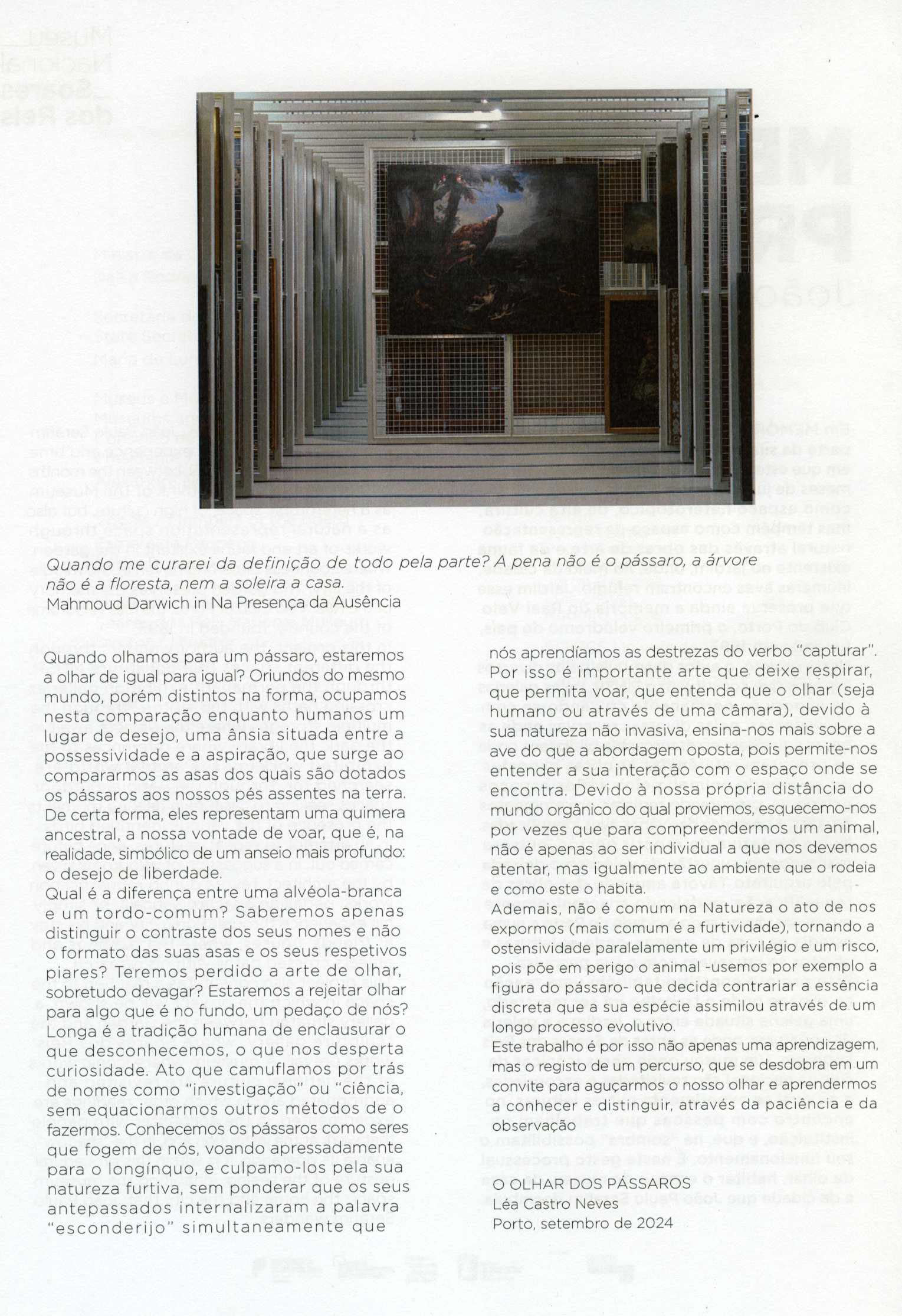"THE GAZE OF THE BIRDS"
TEXT WRITTEN FOR THE NACIONAL MUSEUM SOARES DOS REIS (PORTO)

"When shall I be healed of the definition of all by the part? The feather is not the bird,
The tree is not the forest, nor the threshold of the house."
The tree is not the forest, nor the threshold of the house."
Mahmoud Darwich ("In the Presence of Absence")
When we look at a bird, are we looking from equal to equal?
Coming from the same world, but different in form, as humans we occupy in this comparison a place of desire, a longing situated between the possessiveness and aspiration, which arises when we compare the wings birds are endowed with to our grounded feet on earth. In a way, they represent an ancestral chimera, our desire to fly, that is, in reality, symbolic of a deeper yearning: the eagerness for freedom.
What is the difference between a white-wagtail and a song-thrust? Can we only distinguish the contrast of their names and not the shape of their wings and their respective chirpings? Have we lost the art of looking, especiall slowly? Are we rejecting looking at something that is, in all thruth, a piece of
us? Long is the human tradition of imprisoning what we do not understand, what arouses our curiosity. Act we camouflage behind words like "research" or "science, without pondering other methods.
Coming from the same world, but different in form, as humans we occupy in this comparison a place of desire, a longing situated between the possessiveness and aspiration, which arises when we compare the wings birds are endowed with to our grounded feet on earth. In a way, they represent an ancestral chimera, our desire to fly, that is, in reality, symbolic of a deeper yearning: the eagerness for freedom.
What is the difference between a white-wagtail and a song-thrust? Can we only distinguish the contrast of their names and not the shape of their wings and their respective chirpings? Have we lost the art of looking, especiall slowly? Are we rejecting looking at something that is, in all thruth, a piece of
us? Long is the human tradition of imprisoning what we do not understand, what arouses our curiosity. Act we camouflage behind words like "research" or "science, without pondering other methods.
We know the birds as beings that flee from us, flying
hastily far away, and we blame them for their stealthy nature,
without considering that their ancestors internalized the word "hiding" at the same time that we were learning the verb "capture".
This is why it is important to create art that allows to breathe, allows to fly, and that understands that the gaze (be it human or through a camera), due to its non-invasive nature, teaches us more about a bird than the opposite approach, since it allows us to understand its interaction with the space where it inhabits. Due to our own distance from the organic world where we come from, we forget sometimes that to understand an animal, it is not only to the individual that we should pay attention, but also to it´s habits and the environment that surrounds it.
Moreover, it is not common in nature to expose ourselves (more common is the act of hiding), making the ostensiveness parallelly a privilege and a risk, since it endangers the animal -let us use for example the figure of the bird- that
decide to contradict the discrete essence that it's species has assimilated throughout a long evolutionary process.
This artwork is therefore not only a learning experience, but the record of a path, which unfolds in an invitation to sharpen our gaze and learn how to identify and distinguish, through patience and observation.
hastily far away, and we blame them for their stealthy nature,
without considering that their ancestors internalized the word "hiding" at the same time that we were learning the verb "capture".
This is why it is important to create art that allows to breathe, allows to fly, and that understands that the gaze (be it human or through a camera), due to its non-invasive nature, teaches us more about a bird than the opposite approach, since it allows us to understand its interaction with the space where it inhabits. Due to our own distance from the organic world where we come from, we forget sometimes that to understand an animal, it is not only to the individual that we should pay attention, but also to it´s habits and the environment that surrounds it.
Moreover, it is not common in nature to expose ourselves (more common is the act of hiding), making the ostensiveness parallelly a privilege and a risk, since it endangers the animal -let us use for example the figure of the bird- that
decide to contradict the discrete essence that it's species has assimilated throughout a long evolutionary process.
This artwork is therefore not only a learning experience, but the record of a path, which unfolds in an invitation to sharpen our gaze and learn how to identify and distinguish, through patience and observation.
English Translation of "THE GAZE OF THE BIRDS"
